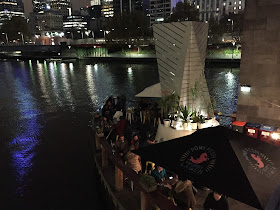Hardware Société
With positive reviews and many lists recommending the Hardware Société (though admittedly, some of these are a bit older), we were not too surprised to find that we would have to wait in line for brunch at this popular cafe.
 |
| Not pictured: the queue to get in. |
Situated on Hardware Street, the eatery has little references to its name, for instance with the wait staff wearing leather aprons. The meals were beautifully presented, with generous portion sizes and skilfully cooked, so it's no wonder the place rates highly. We would happily go to other good cafes without the queues though.
 |
| Huge portions for breakfast: herb roasted mushrooms ($20) and scrambled eggs ($20). |
Frances
We stumbled across Frances Food & Coffee around the corner from our hotel. We loved the decor, and the fact that there were plenty of free tables, though the place was by no means empty.
 |
| Concrete and wood work together at Frances. |
We also loved the food, which was not only simple and delicious, but had more manageable portions at correspondingly smaller prices. The items pictured below cost less than $10 each, and the most expensive thing on the menu was $14, unless you count their unlisted breakfast special ($17), which was a baked dish with sausages and a duck egg.
 |
| Field mushroom toastie ($9.50). |
 |
| Toasted croissant with avocado, Swiss cheese and rose harissa ($8.50). |
The service was attentive and it was also the first time I had a chai latte that was not pre-sweetened. Instead, I was given a little jug of honey that I could mix in to my liking. We would definitely recommend this neat little sibling-run cafe!
 |
| Original chai latte ($4). |
Sir Charles
Unlike the cafes above, Sir Charles was a recent opening in Fitzroy that some friends took us to. Their breakfast menu had some unusual twists that worked surprisingly well.
 |
| Cafe interior. |
Case in point: the Sir Charles Benedict that three-quarters of our table ordered came with panko-crumbed eggs, Sriracha hollandaise and bacon on roti.
 |
| Sir Charles Benedict with panko-crumbed eggs, Sriracha hollandaise and bacon on roti ($17). |
The corn fritters turned out to be deep-fried balls, and some other items on the menu looked just as intriguing, with miso scrambled eggs, for instance. This place should be high on your list if you want to have playful and mouth-watering food.
 |
| Corn fritters with poached egg, charred salsa and spicy hollandaise ($15).. |
Operator 25
Even though we weren't particularly hungry, we couldn't leave Melbourne without checking out Operator 25, which was not only close to our hotel, but was also highly rated.
 |
| Sign outside the cafe. |
This cafe celebrates its heritage as a former telephone exchange in numerous ways, from the "Over Hear!" and "Pick Up Line" signs over the counter, to the bundle of wires hanging from the ceiling.
 |
| Telephone exchange theme inside. |
We went for the most basic item on the breakfast ("Wake-Up Call") menu: toast with a spread, in our case Nutella, which came in a little glass jar with a foil-wrapped piece of handcrafted cultured butter.
 |
| Sourdough with butter and Nutella ($7). |
It was a pity we weren't able to try anything else, because they had some exotic-sounding dishes too, with braised eggs served with ox tongue and corn bread, or a three rice congee with puffed buckwheat, lotus crisps and soy poached egg.
 |
| Couldn't fault the coffee either. |
Bonus: Closed Signs
We will have to pay Melbourne a return visit to sample more of the city's great cafes, but we still managed to derive enjoyment from a couple of closed places we walked past.
 |
| Goneburger. |
 |
| Not open = nope. |
Hopefully, it won't be long before we can come back!




































